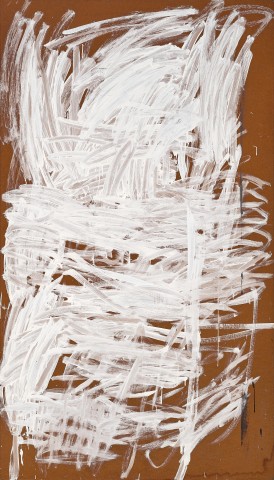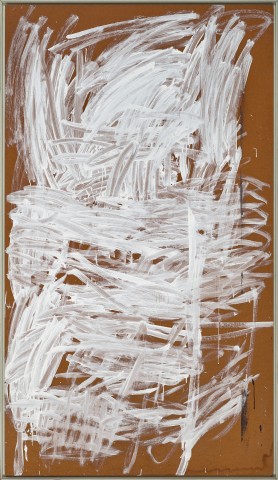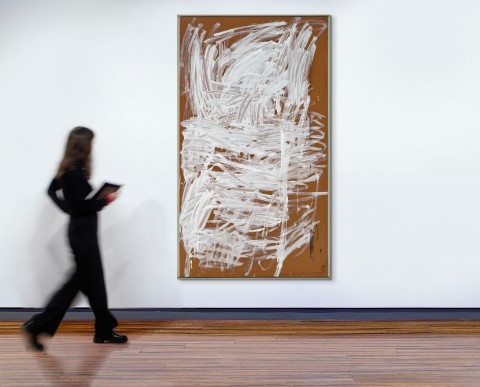UNTITLED NO. 100 (TP209B), 1973
TONY TUCKSON
synthetic polymer paint on composition board
213.5 x 122.0 cm
Estate of the artist, Sydney
Watters Gallery, Sydney
Private collection, Sydney
Tony Tuckson 1921 – 1973: a memorial exhibition, Pinacotheca, Melbourne, 13 – 30 October 1982, cat. 100 (illus. in exhibition catalogue, p. 53)
37 Artists 37 Works, Watters Gallery, Sydney, 1 – 11 October 1986
TUCKSON/TOMESCU, Liverpool Street Gallery, Sydney, 28 November 2009 – 14 January 2010 (illus. in exhibition catalogue as ‘1982 No. 100’)
Great Australian Painting, Liverpool Street Gallery, Sydney, 20 August – 1 October 2022
Thomas, D., Free, R. and Legge, G., Tony Tuckson, Craftsman House, Sydney, 1989, pl. 160, pp. 137 (illus.), 186
Australian art history often holds to a somewhat unreliable habit – identifying the moment an artist secured critical acclaim, then seeing the work that preceded it as a preamble and what followed as, usually, a worthy maturing postscript. This does not work with Tony Tuckson; rather we tend to view his career in reverse. Untitled No. 100, 1973 is a perfect example of this.
When Tuckson first exhibited in 1970, the art world was astonished. We looked backwards, discovering how this extraordinary talent came to produce work which placed him immediately at the forefront of Australian abstraction. Tuckson worked privately and was never pressed to exhibit. At the time he had no idea what anyone thought of his art. He was a prolific weekend painter keeping a professional distance from his role as deputy director of the Art Gallery of New South Wales, where his major interest in Aboriginal and Melanesian art was not shared by trustees.1
There are important characteristics which mark Untitled No. 100 as holding a significant place amongst Tuckson’s final works. He had two exhibitions at Watters Gallery, Sydney, the last in 1973 – the year of his premature death – and the very few late works of such scale are now in public collections.2 These are invariably double-panelled works of layered paint and brushed sgraffito effects where bold, painterly calligraphic sweeps complete an irrepressible expressive wholeness. Hardboard, especially commercial Masonite, was a common support, a surface plane with no resistance, something able to accommodate the physical immediacy in creating each work. The artifice of making art – its façade – was Tuckson’s anathema.
Tuckson’s work from his final decade never suggests any sort of narrative, direct metaphor or muted symbolism. Amongst the impulsiveness we still find a particular measure, gestures of considered determination. Characteristics in the late master work White on Black 1970 – 73 (Art Gallery of Ballarat) also appear in Untitled No. 100; the large vertical format, exposed unprimed Masonite surface and edge-to-edge painterly gestures are a shared feature, yet in our work the differences enter another realm.
Untitled No. 100 abandons restraint. Tuckson seldom spoke openly about his art, and he enjoyed the ambiguity that might be assumed from what he said. It can be an unsafe prospect to read unspoken personal circumstances into an artist’s work, however, in this work the sense of unfettered liberation – a release from all measure and constraint – seems inescapable. Nonetheless it is not reckless nor unwieldy. The overall effect is quite unlike anything in Australian art from the early seventies, but there are discreet yet pointed elements that tie the painterly exuberance to the scale and surface personality of the work. Gestures reach to the edge of the picture plane and give cohesion to the whole; on some occasions single strokes begin at the edge and hold the single-colour orchestrated energy in its precarious urgent poise.
Tuckson was an intuitive expressionist, and it is not a contradiction to say that he painted with a deep understanding of ideas and their potential for his work, borne from experiences with various cultures and a knowledge of the history of art. One might try to discern influences, connections with other artists or cultural associations, but these don’t last the more one becomes absorbed in his work.
Tuckson’s work is an essential part of modern Australian art history and he seemingly never slips from view as the recent exhibition, SYNERGY: Tony Tuckson – drawing into painting, eloquently reveals.3
1. See Mendelssohn, J., Passion and Beauty: the paintings of Tony Tuckson; The Conversation at https://theconversation.com/passion-and-beauty-the-paintings-of-tony-tuc... (accessed June 2023) which includes an account of Tuckson’s role at AGNSW.
2. White lines (vertical) on ultramarine, 1970 – 73 (Art Gallery New South Wales, Sydney); Pink with charcoal lines, 1973 (Art Gallery of South Australia, Adelaide); Pink lines (vertical) on red and purple 1970 – 73 (Queensland Art Gallery | Gallery of Modern Art, Brisbane); Yellow, 1970 – 73 (National Gallery of Victoria, Melbourne) and Pink with Charcoal Lines, 1973 (Art Gallery of South Australia, Adelaide).
3. SYNERGY: Tony Tuckson – drawing into painting, Drill Hall Gallery, The Australian National University, Canberra, 21 April – 18 June 2023.
DOUG HALL AM


